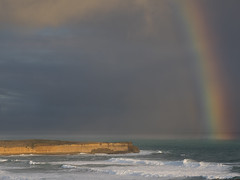Why would you want to use Canon or Nikon flashes on your nice Olympus or Panasonic Four Thirds or Micro Four Thirds camera when the Olympus FL-14, FL-36(R), FL-50(R) flashes are MUCH more intuitive in design and give you full TTL control and in some cases, modeling lights, super FP mode (aka HSS high sync mode if using either FL-36(R) or FL-50(R) with Olympus but not Panasonic cameras), remote TTL (on certain cameras)?
You can of course use third party flashes such as digital flashes from Metz which allow you to use adapters for TTL use with either Olympus/Panasonic, Nikon, Canon, or whatever else interchangeably. But this post assumes you have to resort to using Canon or Nikon specific flashes.
For one, even if you have an Olympus flash, you may not have brought it with you, and for the many Canon and Nikon dSLR users who have been inspired by the Micro Four Thirds approach to photography and are migrating, they will have their Canon or Nikon flashes.
Using Canon or Nikon flashes on these cameras, you WILL LOSE a lot of features due to incompatibilities between systems – TTL exposure, remote TTL exposure, modeling lights, super FP mode (aka HSS high sync mode), and automatic speedlight zoom functionality.
You can place a Canon speedlight (eg. a 580EX II) on your pre-2015 Olympus camera hot shoe and even though it has 5 pins instead of 4 pins, it will work in manual mode, BUT the prudent will use a hot-shoe adapter just in case (see below). Note that from the Olympus OM-D E-M5 mark II camera and onwards, Olympus has added a new hot shoe pin which provides battery power to dedicated Olympus flash units and thus Canon-compatible flash units should NOT be used directly on the hot shoe or via a TTL cord without a dummy adapter which ignores the additional pins!
As an interesting aside, because of the similarities in pins, you can use the Canon Off-Camera Shoe Cord OC-E3 instead of an Olympus cord for FULL TTL and other control of your Olympus flashes when using Olympus or Panasonic cameras!
If you place the speedlight in Manual mode, and you manually adjust the flash output as desired and the zoom (just remember to set zoom to twice the focal length of your lens if you want it matched). If you happen to leave the speedlight in ETTL mode instead of manual, the speedlight will just fire off a full output flash.
For other flashes such as Nikon(but not Sony or Minolta as they have a proprietary flash shoe PC sync pin location which is perhaps THE MAIN REASON I dislike Sony/Minolta cameras – without adapters, they are not compatible with most mainstream flash systems even in manual mode), you should use a hot-shoe adapter.
MAKE SURE the flash has LOW VOLTAGE PC SYNC otherwise you may fry your camera if you directly connect it by wires! Most modern flashes have low voltage sync – beware of old flashes!
Olympus place a WARNING in their manual which states “Do not use a flash unit or other accessory TTL flash that has additional communication functions other than the specified flashes, since it may not only fail to function normally, but may also cause damage to the camera’s circuitry.”
If you are concerned that this may occur, you can buy a cheap hotshoe adapter which only permits communications via the central PC sync pin and this issue will be avoided.
Optical trigger of Canon/Nikon flashes:
- an alternative is to use the built-in flash at a low manual output setting to trigger a remote flash which is connected to an optical sensor trigger device.
- cheap, works well indoors as long as there are no other flashes going off, and as long as you have set your camera flash to manual, otherwise it will send pre-flashes to determine exposure and these will prematurely trigger any remote flash.
- this is a great option when using the Olympus macro/ring flash – but you will have to resort to full manual exposure.
Simple wireless radio trigger of remote flashes:
- this requires a radio transmitter device to be placed in the camera hotshoe (thus negating use of a macro flash unit in the hotshoe), and a receiver device to be attached to each remote flash.
- works very well even outdoors in sunlight or when other photographers are around (most allow selection of channels to avoid conflicts with other photographer’s wireless triggers).
- you are usually required to be in full manual exposure mode as currently, there are no third party systems which allow radio TTL control for Olympus cameras (unlike Pocket Wizards and RadioPoppers for canon and Nikon cameras)
- cheap Chinese models are simple to use and the newer models are generally reliable although have limited range (~10m) – see my post here for details.
Pocket Wizard FlexTT5 and MiniTT1:
- new, expensive TTL-capable radio trigger systems designed either for Canon or Nikon cameras and speedlights
- transmitter can be mounted on an Olympus or Panasonic camera hotshoe (and still provides for a flash to mount on top of it via its hotshoe albeit in manual sync mode only), but the transmitter must be set to non-dedicated camera mode via a computer/USB which may be an issue if you don’t have a laptop with you!
- can potentially provide greater distance and options than the simple Chinese triggers, and of course, you get full TTL control when used with your Canon or Nikon system, along with hyper-sync and HSS functionality.
- see my post here for more details.
RadioPopper JrX:
- new entry level radio triggers designed for Canon or Nikon (unlike PW’s, you just set which system you are using) and instead of mounting on a hotshoe, they attach to the IR transceiver of the speedlight and just convert IR messages to radio then back to IR again.
- when used on Olympus, Panasonic cameras with a Canon or Nikon flash, you should have radio wireless remote triggering BUT in manual exposure mode only.
- it would appear that as long as you are using RP compatible flashes (most Canon/Nikon speedlights except SB-900 which does not have analogue quench system), you should be able to remotely set the flash outputs from the RadioPopper transmitter module.
- see strobist post for more details on the JrX, and my earlier post on the radiopopper X system











Can you advise what sort of adaptor would be necessary to use a Nikon SB600 on a Panasonic G1 ? It fires but only manually – could an adaptor give it TTL capability?
There is currently no technological solution to allow a Nikon flash to work in TTL mode on an Olympus or Canon, nor is it possible for TTL to work with Canon flash on a Nikon or Olympus camera, nor a Olympus Flash on Canon or Nikon camera.
This is because each brand has their own proprietary TTL mechanism and they are not cross-compatible, even if you could get an adapter to line up their pins.
You could use a Nikon flash on an Olympus camera in manual mode but I would advise either off-camera use via a optical or radio trigger device, or use a cheap hotshoe adapter which only has the central pin so that you do not potentially damage either the camera or flash from incorrect pin contacts.
Here is an adapter for manual use but should be safe to use:
http://cgi.ebay.com.au/PC-Sync-Hotshoe-with-Terminal-for-On-Off-Camera-Flash_W0QQitemZ290324997169QQcmdZViewItemQQptZAU_Cameras_Photographic_Accessories?hash=item4398b7e431&_trksid=p3286.c0.m14
Hope this makes sense.
oh, and note in the above comment – where I have stated Olympus, you can put Panasonic, Pentax, Sony, or whatever other brand in.
If you need a flash that can work in TTL mode on different camera systems, you need to consider third party brands such as Metz which makes digital units with interchangeable bases for each camera brand. You will need the latest flashes though for digital camera compatibility.
Surely you can get far better flash photography shots on the Canon or the Nikon flash units on respective cameras than the 4/3 camera. Suddenly you will have to figure out how to use the flash unit manually and may have a big headache to some people for loosing features.
if you know what you are doing, you will get better flash in manual mode, but if you don’t understand flash, you will get better results in ttl mode – albeit variable.